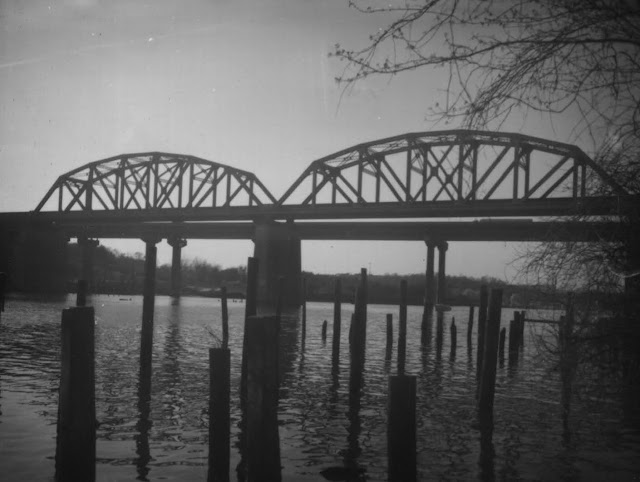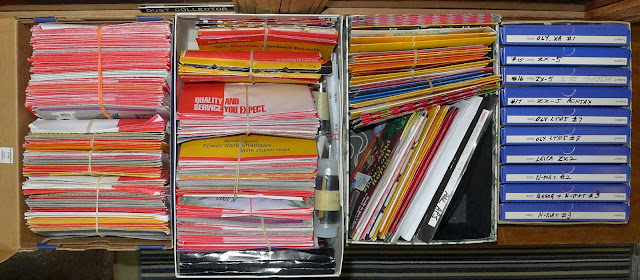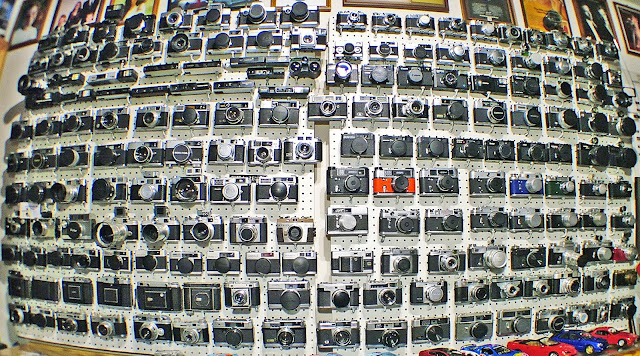January 4, 2021
#412
Gentle reader,
With the proliferation of smart cell phones and digital cameras practically wiping out film sales, would you believe that there are many photographers that STILL use film?
Well, it's like this: Only the largest and most expensive digital SLR or medium format camera can come close to the detail and depth of a film photograph.
Why? The larger the negative, the more information and detail the film can capture.You have probably heard of Ansel Adams, well, he used large format cameras which used sheet fill almost as large as a piece of copy paper. While there may be a sensor that large, the cost would be mind blowing.
These are film negatives, all of which I created with different types of film and cameras over many years, all but one were on ROLLS of film.
Starting at the top is 16mm film. The "mm" refers to millimeters in width. Kodak changed the arrangement of the sprocket holes and called their 16mm film: "Pocket Instamatic" 110 film.
110 film is the baby brother of the next film down, "Instamatic" 126. 126 film is 35mm (135) but with different holes for the winding sprocket. Both 110 and 126 are (were) in cartridges as seen below for easy loading and unloading from the camera:
110 film is still available, but 126 stop being produced in 2008. Below is a 126 film negative, note that the frames are square and unlike the 35mm film, the black lines between frames are not straight and solid.
That is because the cartridges do not do a good job of keeping the film flat and pressed against the camera body around the lens opening. Note the widely spaced sprocket holes which are only on one edge of the film.
This is 35mm film. Note the many sprocket holes on both sides of the film. Note also the crisp lines between frames.16mm, 35mm and 70mm film were originally MOVIE film. The least expensive, which came out much later was 8mm. It was 16mm film slit in two. The movie cameras still used 16mm film, but only one side of the film. One would shoot the whole roll, open the camera and swap the now-full take-up reel with the now-empty film reel over and shoot it again. The developing lab had a machine which slit the film once it was developed and the two ends would be spiced into one long 8mm film with sprocket holes only on one side.
This is 120 film which is 70mm wide. ABOVE is a square 6x6cm frame. What do you see? It does not have sprocket holes unless it is for movies. It, like 110 and 126 has brown on one side and black on the other paper which has numbers on the brown outside and other information printed. The paper prevents light from reaching the film when in the camera and before and after when it is tightly rolled.
220 film is simply a longer roll of 120 with only the paper on the few inches at the end of the roll. It can only be used in more modern cameras which do not have a round film window like the three camera backs you see below:
See how the holes (which are closed except when winding the film) are in different places? The top camera shoots 6x6, the bottom one 6x9.
And this old German camera had the option of shooting different widths of photos. One inserted or removed black frames inside the camera to change widths. See the next paragraph.
120 film can have several sizes of frame, depending upon the camera: 6x4.5, 6x6, 6x7 and 6x9. The numbers mean centimeters. So, 60mm by 45mm, 60mm by 60mm, etc. Ten millimeters equal one centimeter. I have owned all but 6x7cm models. The wider the shot (higher second number) the fewer shots per roll. 120 and 220 film and lots of other numbers no longer used, are called "Medium Format" cameras.
LONG
before film came in rolls, it was flat sheets of film. No doubt you may have
seen a picture such as this one below and wondered what he was doing.

Above is the ONE film frame which I successfully shot with my 4 by five inch "Press Camera" which uses SHEET film.
Below, in a bit, you will see the camera I used to make this shot.
There are still people who use what are called "Large Format" cameras. They use sheets of film which must be loaded into film holders in a darkroom. Usually they hold two sheets, back to back, with a light-tight wall between them, and a light-tight "dark-slide" covers. AFTER the photographer focuses the camera underneath that black cloth, they insert a film holder. Then they remove the FRONT dark-slide, then make the exposure, and reinsert the dark-slide. They can then remove the film holder, compose another shot, insert the film holder again (making sure to use the OTHER side) and make their second exposure. It is the most difficult type of photography.
I found this image and the very old one above it online. These are the three sizes of sheet film holders. 4x5, 5x7 and 8x10, the numbers being in inches.
This is a Burke & James five by seven camera. The film is five inches by seven inches.
This is the back of the camera, the black metal portion is the film holder. They are spring loaded and one has to pry them away from the camera body using those two tabs on the right, to insert a film holder.
If you remove the piece of wood which the film holder is attached to, this is what you will see inside.
What makes using these so difficult is the image is upside down and reversed left to right.
This is the only image I could find. It is a still from a YouTube video.
This is a 1940's Busch Pressman press camera. I have the flash for it too. My father-in-law surprised me with this after he heard that I was collecting cameras.
Above, the viewing door is closed. Below it is opened. The camera has a built-in set of blinds, but they are not as good as a large black cloth.
OK, so now you have learned a bit about medium and large format cameras and sheet film, roll film and what the "mm" means. 35mm cameras were once called "miniature" cameras. Cameras that use 16mm film (including 110) and special spy cameras used special 8mm film are called "subminiature" cameras.
These are all subminiature cameras. Even the tiny one called "Hit-type" cameras actually worked. Not very well, though.
Remember at the beginning when I mentioned the larger the film, the more information and detail in the photos?
It's the same with digital sensors. Even if you have
the smart phone with the best camera available, it's sensor is still TINY.
Most point and shoot digital camera's sensors are also very small as this excellent chart from LENSVID shows:
And camera designers have been able to cram a LOT of red green and blue pixels into a tiny area. But the larger the sensor AND the greater number of pixels there are, the better your photos will look. Almost as good as film.
You may be wondering what prompted me to write this particular article, as it is not exactly what's trending these years.
These photos, top to bottom, tell a story. I spied this Vietnam Veteran Soldier in period uniform looking ready for inspection. I took the shots in such a way so as to not disturb him. When I saw he had found the name he was looking for and knelt down, I leaned against the wall to get this photo. Notice the way the crowd seems to be giving him room and privacy which further adds to the story. I have wondered who he is or was and what his story was. I see the Purple Heart medal and several more I don't recognize.
I was just young enough to miss the Vietnam war and the Draft that accompanied it. I have great respect for the military and those who choose to serve. I joined the Air Force at 19, but they found that I had a heart murmur. It has since gone away, AND I would not be where I am today married to my best friend had I been able to serve. My oldest son served in the Army for six years and was chosen by the Army to go to West Point.
Today, I had posted that set of three photos on Facebook from Memorial Day, 1996. I had an 8 by 10 enlargement made of the last photo back in the day and scanned the other two today.
The photos only had "59" on the back meaning it was the 59th roll of 35mm film I had shot. I opened the closet door and pulled out all the boxes of film negatives, curious as to what camera I had used.
Those are shoe boxes. People have been using them for a very long time to store photos. And I have a lot more holding photos not quite good enough to be put into albums.
Each envelope or box represents ONE roll of film and holds the negatives from each picture. 35mm holds up to 36 exposures, but I always bought 24 exposure rolls.
Do you see those things on the right, above? Those are rolled up 120 film and there is some stored unrolled in sleeves.
The bulging box held six rolls of APS film. APS film was a joint venture between film and camera manufacturers hoping to cash in on 126 film users by creating a new type of "drop in" film. It is 24mm wide film so halfway between 110's 16mm and 35mm. To learn more click on this link: Advanced Photo System - WikipediaKodak and Fujifilm made the most film, at least in North America in my days. And Kodak largely developed it. But Konica also got into the game. However, their use of boxes rather than paper sleeves, takes up a lot more room.
Well, I did not determine which camera (I had collected more than 500 of them and shot with many) I had used that 59th roll in.
But, having some OCD tendencies, I decided to COUNT just how many pictures I had made on film (not counting the many rolls of slide film). Ready?
Seventy-eight cartridges of 110 film for a total of 1872 images.
At least (I think there were more) four rolls of 120 film for 52 images.
Five cartridges of 126 film for 120 photos.
308 rolls of 35mm film, plus one roll shot in a "half-frame" camera for a total of 7392 pictures plus 48 from the half-frame camera.
And lastly, and largest physically, ONE photo from 4x5" sheet film.
GRAND total (less slides) is: 9485 pictures.
And I had to PAY for every single one. Twice. Once for the cost of the film. The second time for the developing and printing of every photo. I don't want to think about how much money that came to.
But that's what everyone, around the world, who could afford a camera and film did for more than 100 years. You could get film and developing almost everywhere. Until digital came along.
But, you know what? I and my children and grandchildren will be able to look through those albums and boxes and see MEMORIES.
No worries about some virus or catastrophic phone failure and losing every picture I shot with my phone. Oh, I use a flip phone and it doesn't even have a camera!
So, curious as to how many different cameras made those almost ten thousand pictures? At LEAST 83. This is a film image I made using a fisheye lens. This is only a fraction of the total number of cameras once in the collection.
So, thank you SO much for taking the time to read our humble blog. Please take a moment to click or tap the FOLLOW button, it's right on the corner of the photo of the large camera with a red bellows. Also, feel free to leave a comment below or on Facebook.
Scott & Nancy
January 4, 2021
#412



































No comments:
Post a Comment